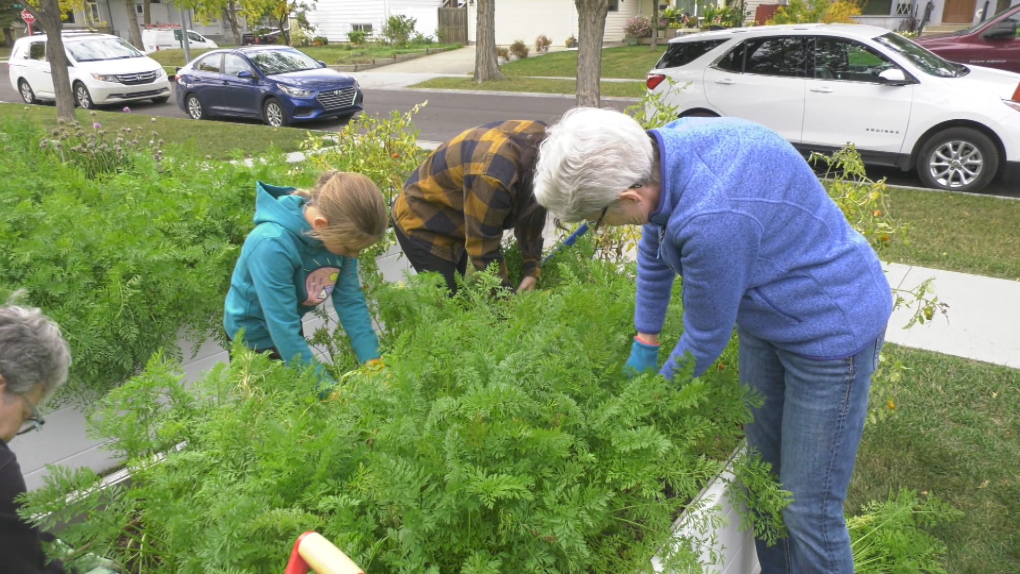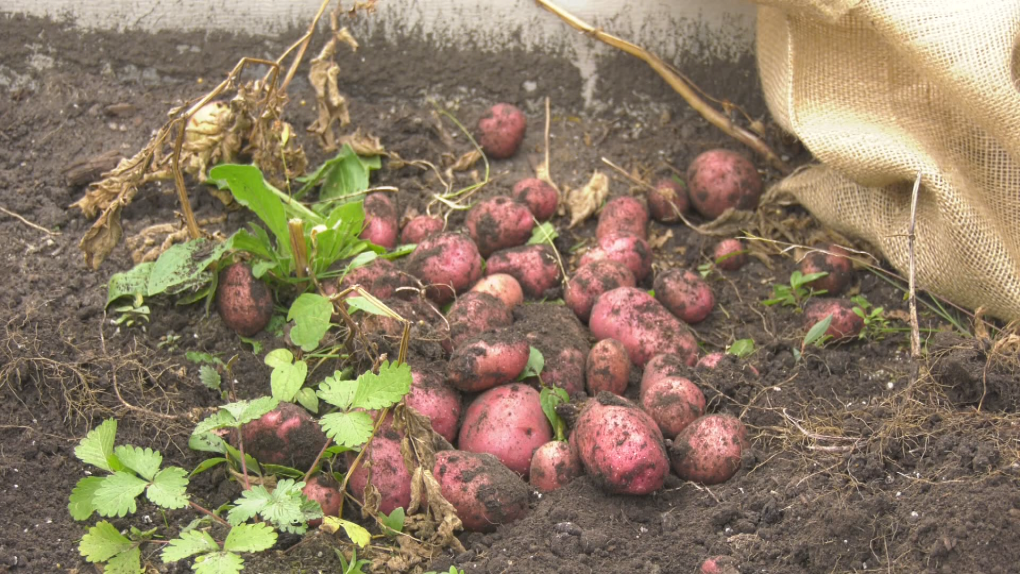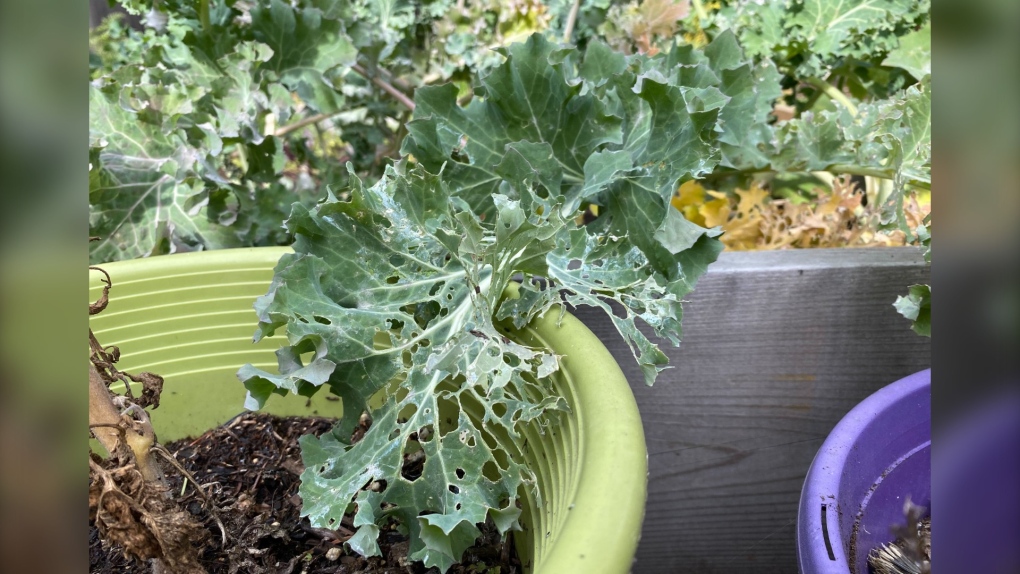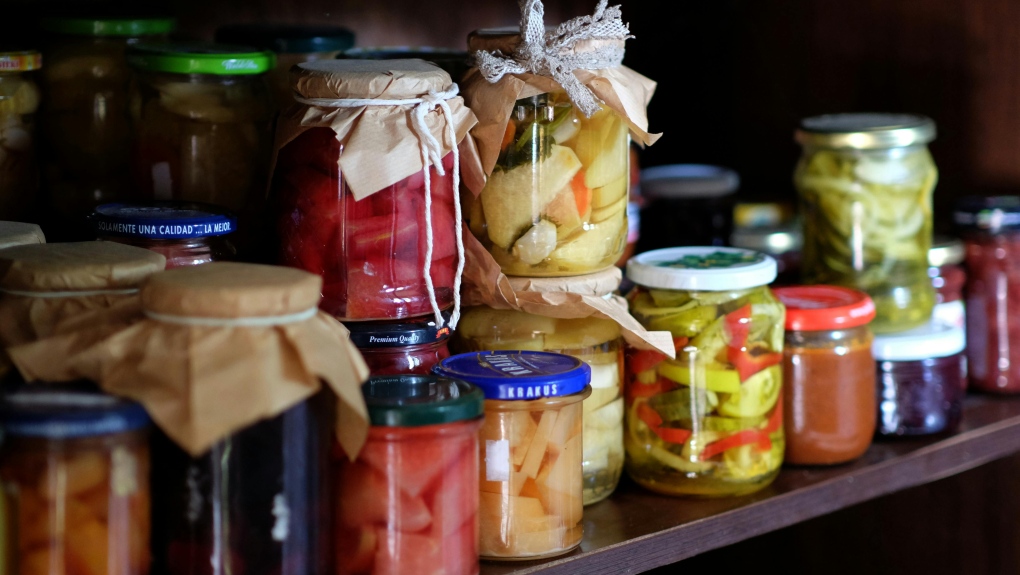What to do with those piles of kale, wormy apples and other garden goodies this fall
 Volunteers help harvest produce grown at St. David's Anglican Church in late September. The produce was grown to be donated to the food bank. (Galen McDougall/CTV News Edmonton)
Volunteers help harvest produce grown at St. David's Anglican Church in late September. The produce was grown to be donated to the food bank. (Galen McDougall/CTV News Edmonton)
For many Edmontonians, the time has come (and nearly gone) to reap what they sowed earlier this year.
Others may have taken advantage of warm September weather to push the picking, plucking, pulling and digging further down the to-do list.
But, time is running out.
Provincial data estimates that Alberta produces around $31 billion in food waste each year, with 47 per cent of that generated at the household level.
If you — like me – are feeling overwhelmed by an overbearing fruit tree or a kale patch that just won't quit, here are some ways to make your fall haul more manageable and help keep good food out of the green bin.
Share the bounty
According to City of Edmonton data, there are 52,734 edible fruit trees in Edmonton.
Even dwarf varieties of apple and pear trees can produce more than 150 pounds of fruit each year. That's understandably more than some are willing -- or able -- to use up at home.
Extra fruit you can't pawn off on friends, family or Facebook Marketplace can be donated to Edmonton's Food Bank (EFB).
The organization also accepts vegetables that are easily handled and stored, such as root vegetables, cabbage, beans, broccoli and squash varieties.
"This time of year we get a lot of potatoes," said Doug Thompson with EFB. "Tomatoes are always a hit, as are peas and lettuce and corn on the cob.
"Garden-fresh produce simply tastes better, and we appreciate every single garden around the city that shares any of its bounty with us. Our clients appreciate it too."
 Potatoes can produce between three and five pounds per plant, and they are commonly donated item to local food banks in the fall. (Galen McDougall/CTV News Edmonton)Crabapples, which make up a whopping 21,000 of Edmonton's fruit trees, unfortunately cannot be donated to the food bank due to their small size and sour profile.
Potatoes can produce between three and five pounds per plant, and they are commonly donated item to local food banks in the fall. (Galen McDougall/CTV News Edmonton)Crabapples, which make up a whopping 21,000 of Edmonton's fruit trees, unfortunately cannot be donated to the food bank due to their small size and sour profile.
"It takes a number of crabapples to equal the food value of one regular-sized apple and often a lot of processing to make them palatable, which takes time or materials our clients often don't have," EFB explains on its website.
Eligible donations, with the majority of dirt removed, can dropped off at the EFB warehouse at 11508 120 St. For more information, visit the food bank's website.
The Leftovers Foundation, a non-profit aimed at reducing food waste, also collects home-grown produce to distribute to campus food banks and social agencies.
"With grocery prices and produce, it's been very difficult for a lot of people to gain access to fresh, good produce, and it's such a big part of a healthy diet," said outreach coordinator Mary Gholami.
Gholami said volunteers can usually come help and harvest donations for people who can't, but this year there weren't enough to keep up with demand.
"We're currently running at a capacity, but we're still able to take any already harvested food," she added.
Gardeners can sign up to donate already-picked fruit and vegetables through the Home Harvest program on the Leftovers Foundation's website.
Food rescue groups won't take fruit or vegetables damaged by pests, but those wormy apples and caterpillar-chewed cabbages don't need to go to waste.
The Farm Animal Rescue and Rehoming Movement (FARMM) is happy to help with anything less desirable, but still edible (such as those crabapples).
"We have about 150 animals that benefit from getting donated produce," said owner Melissa Marttell.
"That seems like a lot for some people, like an entire carload of apples, but if you brought them out here and we fed them, they would disappear in a matter of five minutes."
 Produce with pest damage can be donated to the Farm Animal Rescue and Rehoming Movement, as long as it's not rotten. (CTV News Edmonton) Marttell said apples are a favorite, as are nutrient-rich leafy greens like spinach, kale and Swiss chard. All produce is welcome, she added, as long as it's not rotting.
Produce with pest damage can be donated to the Farm Animal Rescue and Rehoming Movement, as long as it's not rotten. (CTV News Edmonton) Marttell said apples are a favorite, as are nutrient-rich leafy greens like spinach, kale and Swiss chard. All produce is welcome, she added, as long as it's not rotting.
"We like to have a place for people to bring their things so they're not wasting and it's not going into landfills," Martell said. "We can utilize it, so we love that."
For more information on drop-off sites for FARRM donations, visit them on Facebook or Instagram.
Save the season
If you are working with a more manageable haul, you can store a variety of vegetables in your root cellar, with hardy veg like potatoes, carrots and onions lasting upwards of eight months. More information can be found on the Farmers' Almanac website.
No root cellar? No problem. The freezer is an easy place to stash garden goodies.
Vegetables should be quickly blanched in boiling water or steam to kill surface bacteria. Greens like kale and spinach can be chopped and frozen flat in bags or blocks for easy use, while cauliflower florets or brussel sprouts will be easier to use if you freeze them individually on a cookie sheet before bagging them up (same goes for smaller fruit like berries).
And don't forget the ice cube tray, which is a great way to turn your herb garden into herb bombs for punching up soups and stews all winter.
Jams, jellies and pickles can all be stored safely in the pantry, though canning takes a bit more know-how due to the risk of botulism – a serious illness caused by a neurotoxin found in improperly preserved foods
 Preserves are a great way to make your garden's bounty last all year, as long as they're processes properly. (Pexels/Roman Biernacki)According to Health Canada, high-acid foods, like fruit preserves, sauerkraut, pickles and tomatoes will require a boiling water canner. Low-acid foods include most vegetables, dairy and meat and will need a pressure canner.
Preserves are a great way to make your garden's bounty last all year, as long as they're processes properly. (Pexels/Roman Biernacki)According to Health Canada, high-acid foods, like fruit preserves, sauerkraut, pickles and tomatoes will require a boiling water canner. Low-acid foods include most vegetables, dairy and meat and will need a pressure canner.
First-timer canners can learn more at the Edmonton Public Library or take a class before diving in.
Operation Fruit Rescue Edmonton offers a variety of in-person and virtual workshops on preservation, including canning and cider pressing.
On Oct. 27, the New Grocery Movement is holding a free canning and pickling workshop at the Ritchie Community League (canning supplies are included, produce is not.)
For people who enjoy a little funk, fermentation (responsible for the bubbles in beer and kimchi's signature scent) is another tried-and-true preservation method.
The Kitchen at the Stanley A. Milner Library regularly holds in-person and virtual cooking classes, workshops and demonstrations. Check out the website for more information or to find an upcoming class.
Homemade preserves, pickles or other prepared food cannot be donated to food banks, as Alberta Health Services requires that any food for public distribution be prepared in a kitchen with a food handling permit.
CTVNews.ca Top Stories

opinion Tom Mulcair: Prime Minister Justin Trudeau's train wreck of a final act
In his latest column for CTVNews.ca, former NDP leader and political analyst Tom Mulcair puts a spotlight on the 'spectacular failure' of Prime Minister Justin Trudeau's final act on the political stage.
B.C. mayor gets calls from across Canada about 'crazy' plan to recruit doctors
A British Columbia community's "out-of-the-box" plan to ease its family doctor shortage by hiring physicians as city employees is sparking interest from across Canada, says Colwood Mayor Doug Kobayashi.
'There’s no support': Domestic abuse survivor shares difficulties leaving her relationship
An Edmonton woman who tried to flee an abusive relationship ended up back where she started in part due to a lack of shelter space.
opinion King Charles' Christmas: Who's in and who's out this year?
Christmas 2024 is set to be a Christmas like no other for the Royal Family, says royal commentator Afua Hagan. King Charles III has initiated the most important and significant transformation of royal Christmas celebrations in decades.
Baseball Hall of Famer Rickey Henderson dead at 65, reports say
Rickey Henderson, a Baseball Hall of Famer and Major League Baseball’s all-time stolen bases leader, is dead at 65, according to multiple reports.
Arizona third-grader saves choking friend
An Arizona third-grader is being recognized by his local fire department after saving a friend from choking.
Germans mourn the 5 killed and 200 injured in the apparent attack on a Christmas market
Germans on Saturday mourned the victims of an apparent attack in which authorities say a doctor drove into a busy outdoor Christmas market, killing five people, injuring 200 others and shaking the public’s sense of security at what would otherwise be a time of joy.
Blake Lively accuses 'It Ends With Us' director Justin Baldoni of harassment and smear campaign
Blake Lively has accused her 'It Ends With Us' director and co-star Justin Baldoni of sexual harassment on the set of the movie and a subsequent effort to “destroy' her reputation in a legal complaint.
Oysters distributed in B.C., Alberta, Ontario recalled for norovirus contamination
The Canadian Food Inspection Agency has issued a recall due to possible norovirus contamination of certain oysters distributed in British Columbia, Alberta and Ontario.


































